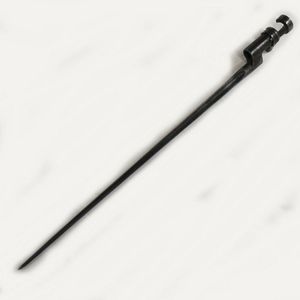Whalebone Walking Stick with Ivory Handle
You must be a subscriber, and be logged in to view price and dealer details.
Subscribe Now to view actual auction price for this item
When you subscribe, you have the option of setting the currency in which to display prices to $Au, $US, $NZ or Stg.
- Ivory - Ivory is a hard white material that comes from the tusks of elephants, mammoth, walrus and boar, or from the teeth of hippopotamus and whales. The ivory from the African elephant is the most prized source of ivory. Although the mammoth is extinct, tusks are still being unearthed in Russia and offered for sale.
Ivory has been used since the earliest times as a material for sculpture of small items, both in Europe and the east, principally China and Japan.
In Asia ivory has been carved for netsuke, seals, okimono, card cases, fan supports, animals and other figures and even as carved tusks.
In the last 200 years in Europe ivory has been used to carve figures, for elaborate tankards, snuff boxes, cane handles, embroidery and sewing accessories, in jewellery and as inlay on furniture. Its more practical uses include being used for billiard balls, buttons, and a veneers on the top of piano keys.
The use and trade of elephant ivory have become controversial because they have contributed to Due to the decline in elephant populations because of the trade in ivory, the Asian elephant was placed on Appendix One of the Convention on International Trade in Endangered Species (CITES), in 1975, and in January 1990, the African elephant was similarly listed. Under Appendix One, international trade in Asian or African elephant ivory between member countries is forbidden. Unlike trade in elephant tusks, trade in mammoth tusks is legal.
Since the invention of plastics, there have been many attempts to create an artificial ivory - Rosewood - A dense timber that varies in shade to very light brown to almost black. When rosewood is cut and sanded the colour of the timber will turn black, and after polishing and exposure to daylight, the surface will gradually lighten over time to light brown with black streaks.
The name comes from the odour emanating from the timber when it is planed, sanded or cut.
Rosewood was very popular for use in Victorian furniture in the second half of the 19th century, and at that time most of the rosewood was imported from Brazil. However it also grows in India and Indonesia.
It is used in the sold for chairs and table legs, but for carcase furniture such as side cabinets and bookcases, and for table tops it is always used as a veneer.
This item has been included into following indexes:
-
walking sticks and canes, material
- ivory or ivory mounted 209
- whalebone 118
Visually similar items

Russian- 1st pattern Mosin Nagant bayonet, 1891, socket, blued 16 inch pointed tip cruciform blade, no scabbard. VGC.

Gold ladies wrist watch 14ct rose gold, dial signed 'Cort', with old cut diamonds and rubies weight approximately 24.6 grams

A lady's diamond Precision cocktail wristwatch, Rolex, circa 1960. Ref. 8916. Serial number 619560. Circular case, silvered dial and applied silver baton numerals. Diamond set bezel and lugs. 18ct white gold. Case, dial, movement and stainless steel bracel

18ct white gold, diamond and sapphire bracelet, designed as three oval plaques pierced and millegrain-set with circular-cut diamonds alternating between sapphire and diamond connectors, length approximately 165 mm.
